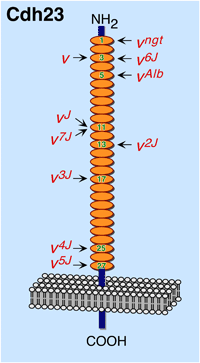| |
| You
are here: About Us |
| Mutations in cadherin-23 cause waltzer and Usher syndrome type 1D |
 |

|
The waltzer (v) mouse mutant shows the classical circling behavior in combination with hearing loss. Through a positional cloning approach, we recently identified the new cadherin Cdh23 in the v locus. Loss-of-function mutations disrupt stereocilia organization during early hair cell differentiation. Based upon the molecular structure and expression profile of Cdh23, we proposed that Cdh23 act as �hair bundle organizer� perhaps by cross-linking stereocilia. Our discovery also lead to the identification of the human homolog, CDH23 and, in collaboration with Christian Kubisch�s group, we showed that loss-of-function mutations in CDH23 cause Usher syndrome type 1D, a recessive disorder characterized by congenital deafness, retinitis pigmentosa and vestibular dysfunction (Bolz et al., 2001). We are currently studying the cellular and molecular function of Cdh23. We also are using the waltzer mouse mutant as model to investigate the pathophysiology associated with Usher syndrome type 1D.
|
|
|















